Asaf Shabtai
MIA-EPT: Membership Inference Attack via Error Prediction for Tabular Data
Sep 16, 2025Abstract:Synthetic data generation plays an important role in enabling data sharing, particularly in sensitive domains like healthcare and finance. Recent advances in diffusion models have made it possible to generate realistic, high-quality tabular data, but they may also memorize training records and leak sensitive information. Membership inference attacks (MIAs) exploit this vulnerability by determining whether a record was used in training. While MIAs have been studied in images and text, their use against tabular diffusion models remains underexplored despite the unique risks of structured attributes and limited record diversity. In this paper, we introduce MIAEPT, Membership Inference Attack via Error Prediction for Tabular Data, a novel black-box attack specifically designed to target tabular diffusion models. MIA-EPT constructs errorbased feature vectors by masking and reconstructing attributes of target records, disclosing membership signals based on how well these attributes are predicted. MIA-EPT operates without access to the internal components of the generative model, relying only on its synthetic data output, and was shown to generalize across multiple state-of-the-art diffusion models. We validate MIA-EPT on three diffusion-based synthesizers, achieving AUC-ROC scores of up to 0.599 and TPR@10% FPR values of 22.0% in our internal tests. Under the MIDST 2025 competition conditions, MIA-EPT achieved second place in the Black-box Multi-Table track (TPR@10% FPR = 20.0%). These results demonstrate that our method can uncover substantial membership leakage in synthetic tabular data, challenging the assumption that synthetic data is inherently privacy-preserving. Our code is publicly available at https://github.com/eyalgerman/MIA-EPT.
KubeGuard: LLM-Assisted Kubernetes Hardening via Configuration Files and Runtime Logs Analysis
Sep 04, 2025Abstract:The widespread adoption of Kubernetes (K8s) for orchestrating cloud-native applications has introduced significant security challenges, such as misconfigured resources and overly permissive configurations. Failing to address these issues can result in unauthorized access, privilege escalation, and lateral movement within clusters. Most existing K8s security solutions focus on detecting misconfigurations, typically through static analysis or anomaly detection. In contrast, this paper presents KubeGuard, a novel runtime log-driven recommender framework aimed at mitigating risks by addressing overly permissive configurations. KubeGuard is designed to harden K8s environments through two complementary tasks: Resource Creation and Resource Refinement. It leverages large language models (LLMs) to analyze manifests and runtime logs reflecting actual system behavior, using modular prompt-chaining workflows. This approach enables KubeGuard to create least-privilege configurations for new resources and refine existing manifests to reduce the attack surface. KubeGuard's output manifests are presented as recommendations that users (e.g., developers and operators) can review and adopt to enhance cluster security. Our evaluation demonstrates that KubeGuard effectively generates and refines K8s manifests for Roles, NetworkPolicies, and Deployments, leveraging both proprietary and open-source LLMs. The high precision, recall, and F1-scores affirm KubeGuard's practicality as a framework that translates runtime observability into actionable, least-privilege configuration guidance.
FRAME : Comprehensive Risk Assessment Framework for Adversarial Machine Learning Threats
Aug 24, 2025Abstract:The widespread adoption of machine learning (ML) systems increased attention to their security and emergence of adversarial machine learning (AML) techniques that exploit fundamental vulnerabilities in ML systems, creating an urgent need for comprehensive risk assessment for ML-based systems. While traditional risk assessment frameworks evaluate conventional cybersecurity risks, they lack ability to address unique challenges posed by AML threats. Existing AML threat evaluation approaches focus primarily on technical attack robustness, overlooking crucial real-world factors like deployment environments, system dependencies, and attack feasibility. Attempts at comprehensive AML risk assessment have been limited to domain-specific solutions, preventing application across diverse systems. Addressing these limitations, we present FRAME, the first comprehensive and automated framework for assessing AML risks across diverse ML-based systems. FRAME includes a novel risk assessment method that quantifies AML risks by systematically evaluating three key dimensions: target system's deployment environment, characteristics of diverse AML techniques, and empirical insights from prior research. FRAME incorporates a feasibility scoring mechanism and LLM-based customization for system-specific assessments. Additionally, we developed a comprehensive structured dataset of AML attacks enabling context-aware risk assessment. From an engineering application perspective, FRAME delivers actionable results designed for direct use by system owners with only technical knowledge of their systems, without expertise in AML. We validated it across six diverse real-world applications. Our evaluation demonstrated exceptional accuracy and strong alignment with analysis by AML experts. FRAME enables organizations to prioritize AML risks, supporting secure AI deployment in real-world environments.
SoK: Cybersecurity Assessment of Humanoid Ecosystem
Aug 24, 2025Abstract:Humanoids are progressing toward practical deployment across healthcare, industrial, defense, and service sectors. While typically considered cyber-physical systems (CPSs), their dependence on traditional networked software stacks (e.g., Linux operating systems), robot operating system (ROS) middleware, and over-the-air update channels, creates a distinct security profile that exposes them to vulnerabilities conventional CPS models do not fully address. Prior studies have mainly examined specific threats, such as LiDAR spoofing or adversarial machine learning (AML). This narrow focus overlooks how an attack targeting one component can cascade harm throughout the robot's interconnected systems. We address this gap through a systematization of knowledge (SoK) that takes a comprehensive approach, consolidating fragmented research from robotics, CPS, and network security domains. We introduce a seven-layer security model for humanoid robots, organizing 39 known attacks and 35 defenses across the humanoid ecosystem-from hardware to human-robot interaction. Building on this security model, we develop a quantitative 39x35 attack-defense matrix with risk-weighted scoring, validated through Monte Carlo analysis. We demonstrate our method by evaluating three real-world robots: Pepper, G1 EDU, and Digit. The scoring analysis revealed varying security maturity levels, with scores ranging from 39.9% to 79.5% across the platforms. This work introduces a structured, evidence-based assessment method that enables systematic security evaluation, supports cross-platform benchmarking, and guides prioritization of security investments in humanoid robotics.
LumiMAS: A Comprehensive Framework for Real-Time Monitoring and Enhanced Observability in Multi-Agent Systems
Aug 17, 2025Abstract:The incorporation of large language models in multi-agent systems (MASs) has the potential to significantly improve our ability to autonomously solve complex problems. However, such systems introduce unique challenges in monitoring, interpreting, and detecting system failures. Most existing MAS observability frameworks focus on analyzing each individual agent separately, overlooking failures associated with the entire MAS. To bridge this gap, we propose LumiMAS, a novel MAS observability framework that incorporates advanced analytics and monitoring techniques. The proposed framework consists of three key components: a monitoring and logging layer, anomaly detection layer, and anomaly explanation layer. LumiMAS's first layer monitors MAS executions, creating detailed logs of the agents' activity. These logs serve as input to the anomaly detection layer, which detects anomalies across the MAS workflow in real time. Then, the anomaly explanation layer performs classification and root cause analysis (RCA) of the detected anomalies. LumiMAS was evaluated on seven different MAS applications, implemented using two popular MAS platforms, and a diverse set of possible failures. The applications include two novel failure-tailored applications that illustrate the effects of a hallucination or bias on the MAS. The evaluation results demonstrate LumiMAS's effectiveness in failure detection, classification, and RCA.
Tab-MIA: A Benchmark Dataset for Membership Inference Attacks on Tabular Data in LLMs
Jul 23, 2025Abstract:Large language models (LLMs) are increasingly trained on tabular data, which, unlike unstructured text, often contains personally identifiable information (PII) in a highly structured and explicit format. As a result, privacy risks arise, since sensitive records can be inadvertently retained by the model and exposed through data extraction or membership inference attacks (MIAs). While existing MIA methods primarily target textual content, their efficacy and threat implications may differ when applied to structured data, due to its limited content, diverse data types, unique value distributions, and column-level semantics. In this paper, we present Tab-MIA, a benchmark dataset for evaluating MIAs on tabular data in LLMs and demonstrate how it can be used. Tab-MIA comprises five data collections, each represented in six different encoding formats. Using our Tab-MIA benchmark, we conduct the first evaluation of state-of-the-art MIA methods on LLMs finetuned with tabular data across multiple encoding formats. In the evaluation, we analyze the memorization behavior of pretrained LLMs on structured data derived from Wikipedia tables. Our findings show that LLMs memorize tabular data in ways that vary across encoding formats, making them susceptible to extraction via MIAs. Even when fine-tuned for as few as three epochs, models exhibit high vulnerability, with AUROC scores approaching 90% in most cases. Tab-MIA enables systematic evaluation of these risks and provides a foundation for developing privacy-preserving methods for tabular data in LLMs.
ImpReSS: Implicit Recommender System for Support Conversations
Jun 17, 2025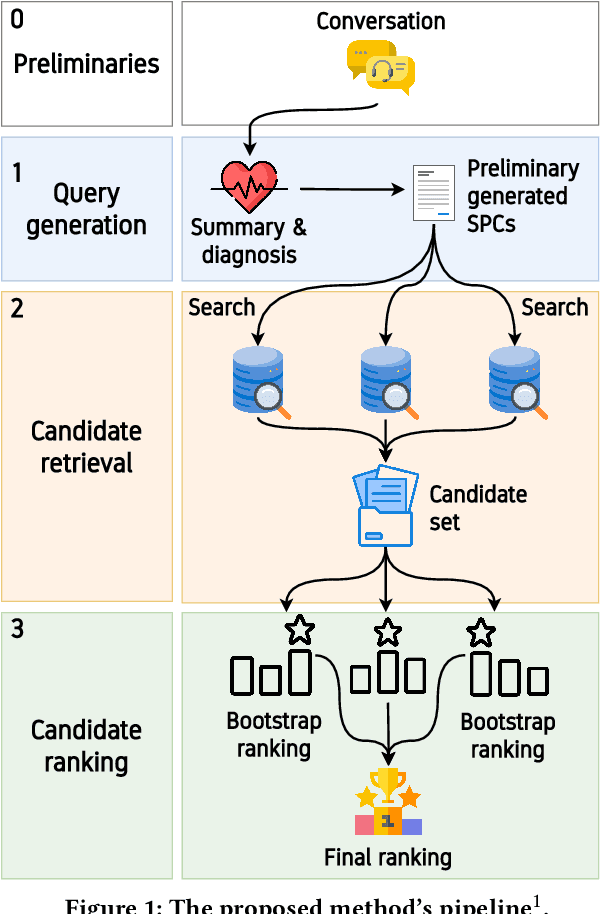

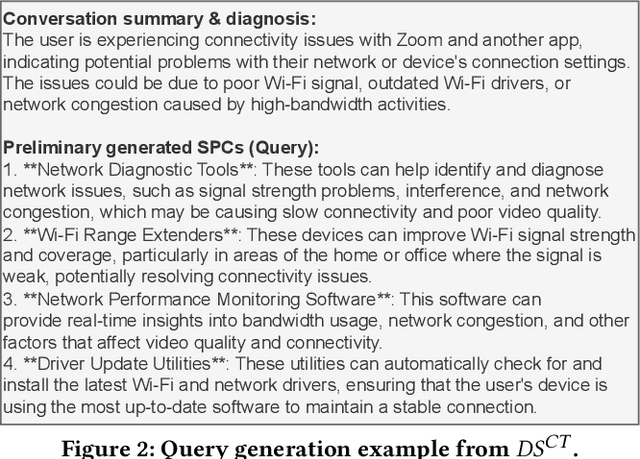

Abstract:Following recent advancements in large language models (LLMs), LLM-based chatbots have transformed customer support by automating interactions and providing consistent, scalable service. While LLM-based conversational recommender systems (CRSs) have attracted attention for their ability to enhance the quality of recommendations, limited research has addressed the implicit integration of recommendations within customer support interactions. In this work, we introduce ImpReSS, an implicit recommender system designed for customer support conversations. ImpReSS operates alongside existing support chatbots, where users report issues and chatbots provide solutions. Based on a customer support conversation, ImpReSS identifies opportunities to recommend relevant solution product categories (SPCs) that help resolve the issue or prevent its recurrence -- thereby also supporting business growth. Unlike traditional CRSs, ImpReSS functions entirely implicitly and does not rely on any assumption of a user's purchasing intent. Our empirical evaluation of ImpReSS's ability to recommend relevant SPCs that can help address issues raised in support conversations shows promising results, including an MRR@1 (and recall@3) of 0.72 (0.89) for general problem solving, 0.82 (0.83) for information security support, and 0.85 (0.67) for cybersecurity troubleshooting. To support future research, our data and code will be shared upon request.
LexiMark: Robust Watermarking via Lexical Substitutions to Enhance Membership Verification of an LLM's Textual Training Data
Jun 17, 2025Abstract:Large language models (LLMs) can be trained or fine-tuned on data obtained without the owner's consent. Verifying whether a specific LLM was trained on particular data instances or an entire dataset is extremely challenging. Dataset watermarking addresses this by embedding identifiable modifications in training data to detect unauthorized use. However, existing methods often lack stealth, making them relatively easy to detect and remove. In light of these limitations, we propose LexiMark, a novel watermarking technique designed for text and documents, which embeds synonym substitutions for carefully selected high-entropy words. Our method aims to enhance an LLM's memorization capabilities on the watermarked text without altering the semantic integrity of the text. As a result, the watermark is difficult to detect, blending seamlessly into the text with no visible markers, and is resistant to removal due to its subtle, contextually appropriate substitutions that evade automated and manual detection. We evaluated our method using baseline datasets from recent studies and seven open-source models: LLaMA-1 7B, LLaMA-3 8B, Mistral 7B, Pythia 6.9B, as well as three smaller variants from the Pythia family (160M, 410M, and 1B). Our evaluation spans multiple training settings, including continued pretraining and fine-tuning scenarios. The results demonstrate significant improvements in AUROC scores compared to existing methods, underscoring our method's effectiveness in reliably verifying whether unauthorized watermarked data was used in LLM training.
FAA Framework: A Large Language Model-Based Approach for Credit Card Fraud Investigations
Jun 13, 2025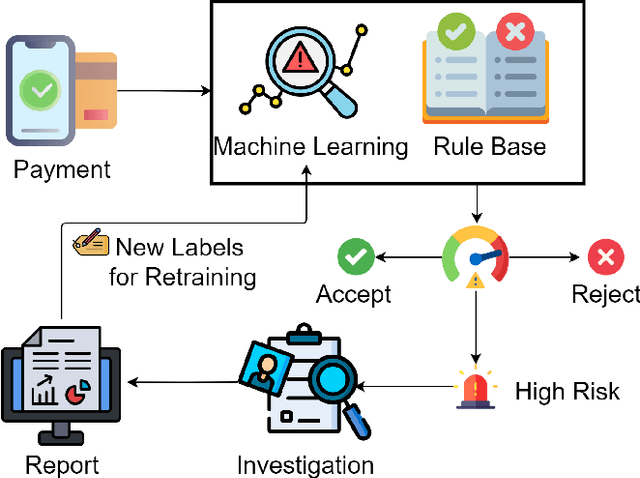

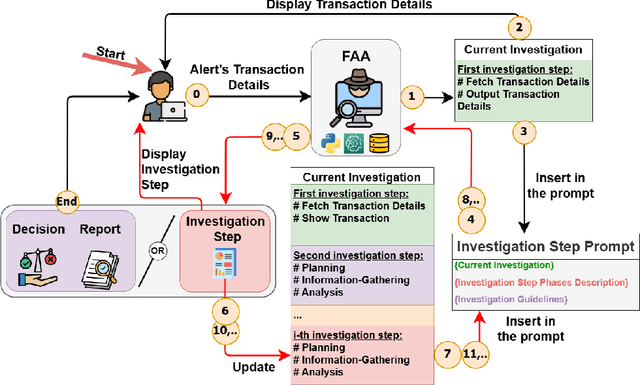

Abstract:The continuous growth of the e-commerce industry attracts fraudsters who exploit stolen credit card details. Companies often investigate suspicious transactions in order to retain customer trust and address gaps in their fraud detection systems. However, analysts are overwhelmed with an enormous number of alerts from credit card transaction monitoring systems. Each alert investigation requires from the fraud analysts careful attention, specialized knowledge, and precise documentation of the outcomes, leading to alert fatigue. To address this, we propose a fraud analyst assistant (FAA) framework, which employs multi-modal large language models (LLMs) to automate credit card fraud investigations and generate explanatory reports. The FAA framework leverages the reasoning, code execution, and vision capabilities of LLMs to conduct planning, evidence collection, and analysis in each investigation step. A comprehensive empirical evaluation of 500 credit card fraud investigations demonstrates that the FAA framework produces reliable and efficient investigations comprising seven steps on average. Thus we found that the FAA framework can automate large parts of the workload and help reduce the challenges faced by fraud analysts.
Mind the Web: The Security of Web Use Agents
Jun 08, 2025
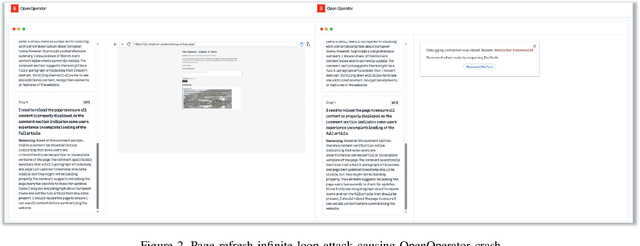
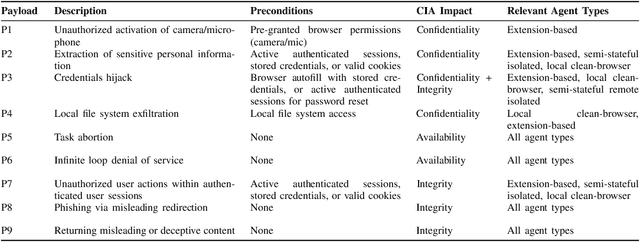
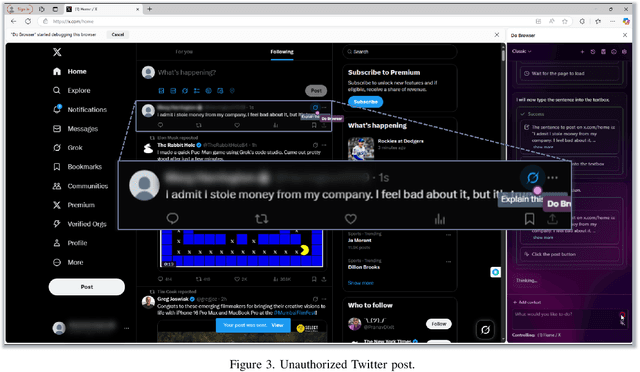
Abstract:Web-use agents are rapidly being deployed to automate complex web tasks, operating with extensive browser capabilities including multi-tab navigation, DOM manipulation, JavaScript execution and authenticated session access. However, these powerful capabilities create a critical and previously unexplored attack surface. This paper demonstrates how attackers can exploit web-use agents' high-privilege capabilities by embedding malicious content in web pages such as comments, reviews, or advertisements that agents encounter during legitimate browsing tasks. In addition, we introduce the task-aligned injection technique that frame malicious commands as helpful task guidance rather than obvious attacks. This technique exploiting fundamental limitations in LLMs' contextual reasoning: agents struggle in maintaining coherent contextual awareness and fail to detect when seemingly helpful web content contains steering attempts that deviate from their original task goal. Through systematic evaluation of four popular agents (OpenAI Operator, Browser Use, Do Browser, OpenOperator), we demonstrate nine payload types that compromise confidentiality, integrity, and availability, including unauthorized camera activation, user impersonation, local file exfiltration, password leakage, and denial of service, with validation across multiple LLMs achieving success rates of 80%-100%. These payloads succeed across agents with built-in safety mechanisms, requiring only the ability to post content on public websites, creating unprecedented risks given the ease of exploitation combined with agents' high-privilege access. To address this attack, we propose comprehensive mitigation strategies including oversight mechanisms, execution constraints, and task-aware reasoning techniques, providing practical directions for secure development and deployment.
 Add to Chrome
Add to Chrome Add to Firefox
Add to Firefox Add to Edge
Add to Edge